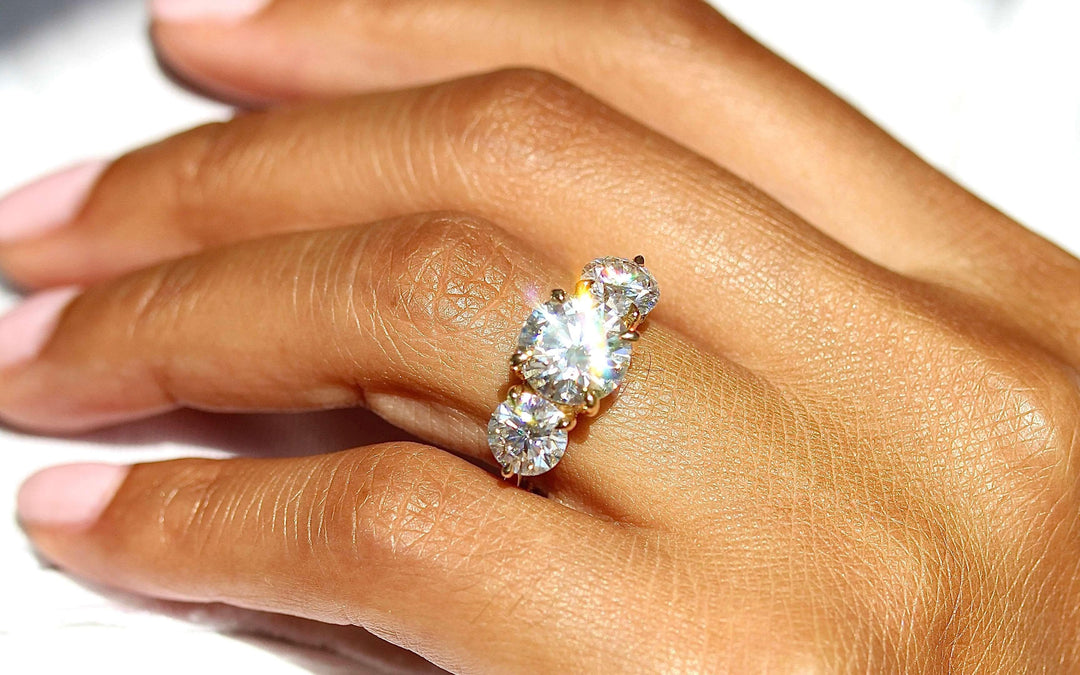Carat Vs. Karat: Everything You Need to Know

Key Takeaways
- The difference between carat and karat is that carat represents a gemstone’s weight and karat signifies gold’s purity.
- Carat weight does not indicate gemstone size.
- Mined diamond prices rise exponentially with carat weight due to rarity, while lab-grown diamonds offer larger sizes at lower costs.
- The karat system is based on 24 parts, with 24K representing pure gold. To improve strength and durability, gold is alloyed with other metals like copper or silver. This mix not only reinforces the metal but can also influence its color.
Carat vs. karat. These are two words you’ve probably seen while shopping for rings, and two of the most commonly mixed-up terms in jewelry. They sound identical, but they refer to very different things. “Carat” is a measure of gemstone weight, while “karat” indicates how much gold is in an alloy (or piece of jewelry). Understanding the difference between carat and karat can help you make more confident, informed decisions when selecting your engagement ring or jewelry.
Carat: How Much Does Your Diamond Weigh?

Carat (abbreviated as “ct”) is the standardized metric unit used to measure the weight of diamonds and other gemstones. One carat equals 0.2 grams (200 milligrams). So, a gemstone that weighs 1 gram is a 5ct gemstone. In other words, to get a gemstone’s carat weight, multiply its gram weight by 5.
To help you remember the difference between carat vs. karat, carat is one of the 4 Cs of diamond grading:
- Carat: The diamond’s weight.
- Cut: How the diamond interacts with light (brilliance and sparkle).
- Clarity: Measures the absence of inclusions.
- Color: The lack of color in a diamond.
So, when you see the “C” in front of “carat,” you know you’re dealing with diamonds (or other gemstones).
Carat Weight Doesn’t Represent Gemstone Size
It’s important to note that a higher carat weight doesn’t always signify a larger gemstone. That’s a common misconception, and an understandable one since carat is so often used as a proxy for size. But a gemstone’s shape and cut can also influence its perceived size. For example, elongated shapes like marquise, pear, and oval may look larger than a round diamond of the same carat weight because of how the weight is distributed, while emerald, radiant, and cushion diamonds may appear smaller because they carry more weight on the bottom. If you want to know how big a diamond will look on your finger, check the dimensions, as well!
How Carat Weight Affects Value
When analyzing carat vs. karat, the value of either material (whether gemstone or gold) is often a top priority. For example, a 2ct mined diamond isn’t just twice the price of a 1ct; its value increases exponentially because of how much more earth must be mined to obtain larger gemstones.
We must stress that exponential increases are much more severe when you’re dealing with mined diamonds. Although the price of lab-grown diamonds and created gemstones still scales with size due to the higher cost of production and materials, the increments are much smaller because mining doesn’t play a role. This means you can get a bigger, better diamond when you opt for lab-grown over mined.
Ethical Considerations & Alternatives
For many customers, carat weight and value are not the only factors to consider. Mined diamonds also come with ethical and environmental concerns. At Taylor Custom Rings, we believe that beauty doesn’t have to come at the expense of people or the planet. Our lab-grown diamonds offer a mine-free alternative. Created in controlled environments, they reduce environmental impact and avoid the ethical challenges associated with mining. Choosing lab-grown diamonds supports a more responsible and thoughtful approach to fine jewelry.
Karat: How Much Gold Is In Your Ring?

Next in our carat vs. karat guide, let’s talk about gold karats. Karat, abbreviated as “kt” or just “K,” is the measurement used to indicate the purity of gold, or what percentage of a metal alloy is gold.
Pure gold is actually very soft and malleable, so it’s not a practical material for making jewelry that’s meant to be worn. That’s why it’s typically mixed with other metals, such as silver, copper, zinc, palladium, and others, to create an alloy that’s more appropriate for everyday wear. The metals used to strengthen pure gold also affect its color. The main difference between yellow and rose gold is that rose gold contains more copper, causing its signature pinkish-orange glow! White gold, on the other hand, has more white metals in it, like silver, palladium, and nickel.
A Brief Overview of the Karat System
To better understand the difference between carat and karat, it helps to look at how gold purity is measured using the karat system, which is based on 24 total parts.
- 24K: 24 parts gold (pure) - too soft for daily wear
- 22K: 22 parts gold and 2 parts other metals - very soft, but used in some cultures for traditional jewelry
- 18K: 18 parts gold and 6 parts other metals - good balance of gold content and durability, has slightly more yellow hue than 14K
- 14K: 14 parts gold and 10 parts other metals - most popular due to its desirable color, gold content, relative durability, and value
- 10K: 10 parts gold and 14 parts other metals - most durable and accessible in value, but with less pure gold content and paler color
14K gold tends to be the most popular purity for jewelry because it offers the classic, lustrous look of pure gold, but it’s much more durable and long-lasting.
How Karats Affect Price
Once again, the discussion of carat vs. karat does affect price and value, whether you’re talking about gemstones or gold. The karat scale is much more straightforward than carat weight because you’re paying for a certain amount of pure gold, and gold’s price is standardized. In other words, two ounces of pure gold are worth twice as much as one ounce of pure gold.
Of course, there are other factors that also affect price when you’re shopping for jewelry, such as the piece’s design and craftsmanship.
We’re Here to Help

Understanding the difference between carat and karat helps you make thoughtful, intentional choices, whether you're exploring lab-grown diamonds, choosing your metal, or comparing ring styles. We encourage our customers to pursue the colors, shapes, and sizes they’re most drawn to, since jewelry can be such a personal expression.
If you have any questions about carat vs. karat, get in touch! You can also shop engagement rings, wedding bands, and other jewelry and gifts, or start your custom design.







